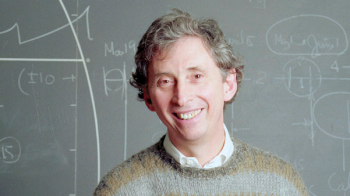Lucien Montanet, one of the closest colleagues of Charles Peyrou, who died on 6 April, recalls Peyrou’s major contributions to physics and to research at CERN.
In 1938 the “mesotron” (now known as the muon, µ) was discovered in cosmic rays. After a few years of uncertainty, a justly famous experiment showed that the mesotron was not Hideki Yukawa’s meson (the pion, π), and soon after, in 1947, the π meson was itself discovered in cosmic-ray showers. That same year, the discovery of strange particles, again in cosmic rays, caused great excitement among physicists. It was in this particularly stimulating context that Charles Peyrou began his brilliant career as a physicist.
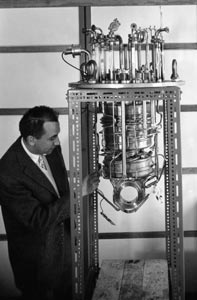
With strong support from Louis Leprince-Ringuet, Charles took part in the building of the first Wilson chamber at the Ecole Polytechnique and in its installation at an altitude of 1000 m at Largentière, near Briançon. In 1947 Charles used this chamber, which was equipped with a magnetic field, to measure the mass of the µ (mµ = (212 ± 5) me). However, he did not observe any mass close to 1000 me, as had been detected at Largentière in 1943 and which was no doubt the first observation of the K+ in the history of physics.
Charles also studied the kinematic properties of the showers (due to the multiple production of π mesons) observed in cosmic rays, but he understood as early as 1949 that the study of pions had become a matter for accelerators. By contrast, cosmic rays were still an excellent source of muons, and in 1951, together with André Lagarrigue at the Ecole Polytechnique, Charles used them to measure the electron spectrum from µ decay and to provide the first estimate of the Michel parameter, ρ, different from zero. The following year, using the same apparatus, he obtained a first indication of the hypothesis that electrons and muons have different lepton numbers, because no electrons were observed in the capture of the µ by the nuclei (upper limit of 5%).
Reflecting on the possible causes of the absence of K+ in the data taken at Largentière in 1947, 1948 and 1949, Charles realized that this failure could be due either to too short a lifetime of the K+ compared with the muons, or to the fact that the energy of the primary cosmic-ray particles selected for the experiment was too low.
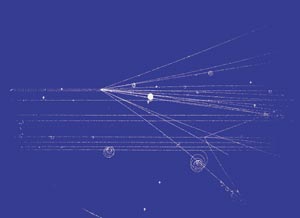
With the agreement of Bernard Gregory, Charles persuaded Leprince-Ringuet to set up an experiment at 2800 m on the Pic du Midi in the Pyrenees with two large superimposed Wilson chambers – a large magnetic chamber placed on top of a chamber fitted with copper plates. Nuclear reactions of cosmic rays occurred in a lead absorber placed immediately above the magnetic chamber, allowing short-lived secondary particles to be detected. It was hoped that the high altitude of the Pic du Midi would mean that a non-negligible fraction of the nuclear interactions would be of high energy. In 1953, after the experiment had been running for a few months, the first two examples of K mesons passing through the first chamber and stopping in the second were observed.
Following a series of results that gave credence to the existence of a whole spectrum of heavy mesons, the Pic du Midi experiment showed that the K± had a unique mass. In addition, the close similarity in range of the muons from K+ decay made it possible to affirm that the majority of K particles emitting a µ suffered a two-body decay, contrary to the view generally held at the time.
The Pic du Midi experiment produced many other interesting results until 1955, but in 1956 cosmic rays were overtaken by accelerators, at least for the study of elementary particles, and the Wilson chambers were replaced by bubble chambers.
The first hydrogen bubble chambers at CERN
On his arrival at CERN in 1957, four years before the commissioning of the PS, Charles embarked on the difficult but very promising task of building liquid-hydrogen bubble chambers. A first prototype hydrogen bubble chamber, the 10 cm chamber, was built at CERN in 1957 under Charles’s direction. It was first used in 1958 in an experiment in a 270 MeV π– beam from the SC, making it possible to analyse the elastic scattering π– + p → π– + p. The results were of no particular interest to Charles who was, however, very proud of the quality of the tracks obtained in the first prototype.
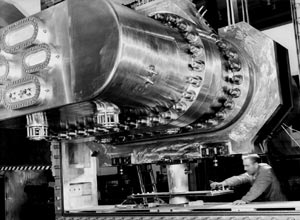
The experience acquired with the 10 cm prototype made it possible in 1958 to start constructing a 30 cm chamber, this time with a 1.5 T magnetic field. This chamber was used for a few experiments at the SC in 1959 (π+ + p → π+ + π+ + n, π++ p → π+ + π0+ p). With these data it proved possible to demonstrate the exceptional qualities of the chamber, such as efficiency, spatial precision with a “maximum detectable momentum” of 90 GeV/c, and ionization measurements. These characteristics made it a very useful detector, despite its small dimensions, when the PS first started up in 1960. The 30 cm chamber allowed successful exploration of the multi-GeV physics supplied by the first PS beams (16 GeV/c π– and 24 GeV/c protons), and Charles was to make an active contribution to the analysis and interpretation of these data.
Ever since his first research into multi-pion production in the hadronic interactions of cosmic rays, Charles had been particularly interested in these interactions. Now “his” 30 cm bubble chamber and the PS provided him with the opportunity to give free vent to his imagination, allowing him to develop methods of analysing these complex interactions, such as the “Peyrou plot” and the “principal axis”. Naturally, in these experiments he was also interested in the production of strange particles, including the first indications of the leading particle effect, angular correlations, etc.
An engineer and a physicist
The next step in the construction of hydrogen bubble chambers was an ambitious extrapolation as it entailed building a 2 m chamber rather than a 30 cm one, with all the new associated problems relating to cryogenics, the very important issue of safety, optics, etc. Charles approached all these technical problems with the same enthusiasm as he did for physics, and he succeeded in surrounding himself with an excellent team of engineers and technicians. An engineer himself, Charles was never the type to be condescending about technology. His all-embracing curiosity led him to take part in discussions on the austenitic transformations of steel at low temperature as readily as on the spin of the Λ. That was why his technical team respected him and was as devoted to him as his group of physicists.
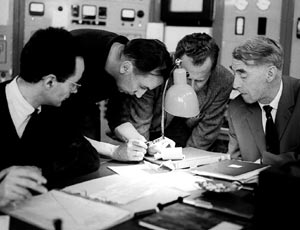
In 1961 the PS started to deliver good-quality separated beams, and as several years more work were needed to complete the 2 m chamber, Charles, John Adams and Bernard Gregory had proposed in 1960 that Saclay’s 81 cm hydrogen bubble chamber should be installed at the PS. In 1961, a series of experiments using this chamber began that would provide essential data on the spectrum and properties of hadronic resonances: low-energy antiproton annihilation; 3, 3.6 and 5.7 GeV/c antiproton interactions; 4 and 6 GeV/c π+ scattering; 3 and 3.5 GeV/c K+ scattering; experiments on the formation of baryonic resonances of strangeness -1 with K– from 400 to 1200 MeV/c, and so on.
Special mention must be given to the original experiment carried out in 1962 with K– at rest, to study the relative Σ – Λ parity. This parity, long debated between the proponents – of whom Charles was one – and opponents of the eight-fold way, had been exercising physicists’ minds for several years. Benefiting from the good performance of the Saclay 81 cm chamber, the new experiment accumulated 150 events of the type K– + p → Σ0 + π0, where the Σ0 undergoes the three-body decay Σ0 → Λ + e+ + e–. This unambiguously showed that the relative Σ – Λ parity is positive. In addition, this experiment made it possible to study the leptonic decays of the Σ+ and the Σ–. The absence of Σ+ → µ+ + ν + n and Σ+ → e+ + ν + n decays confirmed the validity of the then highly controversial ΔQ/ΔS = +1 rule.
The motivation for performing a wide range of experiments was naturally founded on scientific interest, but there was also an intent to meet the demands of many European universities. Charles attached considerable importance to this latter issue, for his interest in physics was equalled only by his interest in CERN and its users. Beneath an exterior that was sometimes regarded as imperial, lay a fundamentally liberal temperament, convinced as he was that research depended on the unfettered initiative of the physicists. He applied this liberalism equally to both his group and outside the laboratory. This method of directing, with the dispersed effort that it entailed, might sometimes have had a negative impact on the efficiency with which the PS and the bubble chambers were run, but it did great service to European physicists, who at the time were not as accustomed to collaborative efforts as they are now.
Charles Peyrou did CERN a considerable service in establishing international collaborations. It was at his initiative that the Track Chamber Committee (TCC) was set up. Its purpose was to receive all the experimental proposals from physicists throughout the world, and then to filter these proposals because then, like now, demand outweighed the available resources. Charles often played a crucial role in this selection process, with his sound judgement of the merits of a given physics issue and certainly with his knowledge of the PS’s potential, the available beams and the detector performances. In this respect, it can be said that the fine results obtained using the 81 cm chamber often bore Charles’s stamp.
The year 1965 was marked by the commissioning of the 2 m chamber and the creation of the 10 GeV/c K– beam with RF separators. This beam was essential for producing the Ω–, which had been suggested by Murray Gell-Mann at the CERN conference in 1962, and which was to be the jewel in the crown of his SU(3) theory. The production of the Ω– required the construction of a K– beam of at least 3.2 GeV/c. Some months prior to the commissioning of the 2 m chamber, the first two Ω– were discovered at Brookhaven using a 200 cm (80 inch) chamber and a 5 GeV/c separated K– beam. In the period before the 2 m chamber started up, the 10 GeV/c K– beam was used at CERN in conjunction with the 1.5 m British bubble chamber in early 1965, and three Ω– were observed, corresponding to the decay Ω– → Λ + K–. (Analysis of the photos obtained in the 2 m chamber exposed to the 10 GeV/c K– beam was to provide 15 Ω–).
In 1970, Charles maintained the view, contrary to general opinion, that the 2 m chamber could be effectively used in certain instances to study weak interactions. (It was accepted at the time that weak interactions were the preserve of heavy-liquid chambers). He therefore encouraged data-taking, with the 2 m chamber, on the reaction K+ + p → K0 + p + π+ with 1.2 GeV/c incident K+. The aim was to study K0 decays. The quality of the kinematical measurements in the 2 m chamber made it possible to define accurately the K0 trajectory independently of its possible decay over a distance corresponding to several K0s lifetimes. This experiment was to produce original results on the ratio between the amplitude for K0s → π+π–π0, and that corresponding to CP conservation, K0L → π+π–π0, as well as on the ΔQ = ΔS rule for Ke3 and Kµ3.
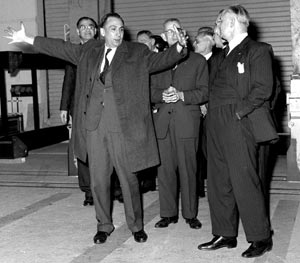
Charles also played an important role in the saga of neutral currents. The search for neutral currents called for the rapid installation of Gargamelle, the heavy-liquid bubble chamber whose components were built at Saclay, in a neutrino beam at CERN. The bubble chamber was installed in record time despite some unforeseen accidents such as the fire that damaged the beam in 1969. Gargamelle’s first exposures to the neutrino beam were made in March 1971.
The discovery of neutral currents
It is interesting to note that, in his report of activities for 1972, Charles gave priority for the first time to the results obtained on weak interactions with the heavy-liquid chambers, which demonstrated the proportionality with energy of the cross-sections. He also noted that the theory of weak interactions predicted the existence of neutral currents that would be able to generate events of the type νµ + e– → νµ + e– (leptonic neutral currents).
No event of this kind was observed, but the sensitivity of this first phase of the experiment was still too weak for precise conclusions to be drawn. This limitation was eliminated the following year with a detailed analysis of the events corresponding to “hadronic” neutral-current candidates of the type νµ + nucleon → νµ + hadrons, whose cross-section is much larger than that of leptonic neutral currents but for which the background (due to uncontrolled incident neutrons) is much greater. The Gargamelle collaboration nevertheless concluded in July 1973 that neutral currents existed. This result was confirmed in spectacular fashion by the observation of two leptonic events several months later. The experiment made it possible to determine, for the first time, the mixing parameter in the Weinberg-Salam theory, sin2θ = 0.39 ± 0.05.
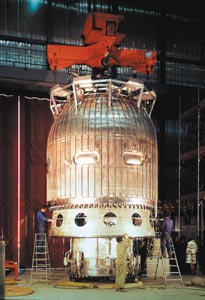
The discovery of the existence of neutral currents was initially received with a great deal of scepticism by several eminent scientists and, after an in-depth and unbiased study of the arguments put forward by Paul Musset and colleagues in the Gargamelle collaboration, Charles became one of the most eloquent defenders of this important discovery.
In the 1970s, convinced that future research at the SPS required the use of giant bubble chambers, Charles launched the construction of BEBC, a 4 m diameter hydrogen bubble chamber equipped with a superconducting magnet. This bubble chamber arrived at just the right time to supplement Gargamelle’s neutrino physics results. Exposed to 70 and 110 GeV/c K±, π±, p± beams, it also provided the opportunity for studying hadronic interactions at SPS energies.
However, BEBC could not reach the spatial resolution at the vertex required to observe short-lived particles such as the D0, D+ and DS. In addition, the identification of these particles required good identification of the secondary particles. Charles therefore encouraged members of his group to propose the construction of a detector assembly (the European Hybrid Spectrometer, EHS) which, in conjunction with a small rapid-cycling hydrogen chamber and electronic detectors, made it possible to detect and accurately measure the properties of these new particles. The EHS in fact supplied the first lifetime measurements, branching ratios and cross-sections for the production of charmed particles.
After the EHS, bubble chambers were replaced by other experiments that were equipped with high-precision vertex detectors and allowed the accumulation of information with the statistics required for particle physics in the 1980s. Charles always made himself available to give advice, make suggestions and give a critical response to new projects, bringing his curiosity and passion to the fore in equal measures.
All those who knew Charles Peyrou well will recognize his brilliant intelligence, his incisive and enquiring mind, his unusual, colourful and extrovert personality, his generosity and humanity, and his capacity to be passionately interested in science, history, music, the theatre, and in everything that made life fascinating.







